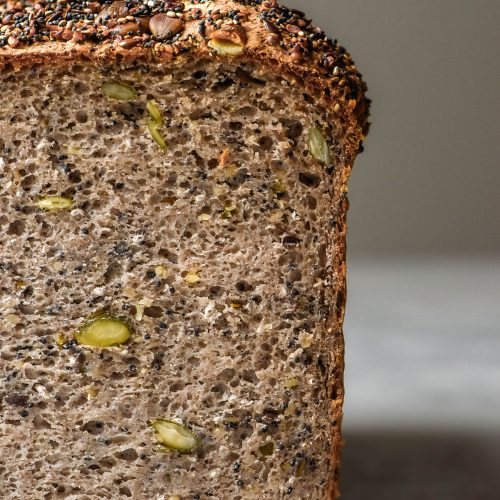
Seeded buckwheat bread
Gluten free, vegan, nut free, xanthan gum free*This recipe uses Australian tablespoons, which are 20ml as opposed to the more common 15ml. If you are not based in Australia, use 4 teaspoons instead (4 x 5ml teaspoons = 20ml)
Equipment
- small USA pan steel Pullman pan – 23cm length X 10cm width X 10cm height (9 X 4 X 4 inches)
Ingredients
For the bread:
- 500 g light buckwheat flour
- 100 g tapioca flour or cassava flour
- 10-12 g fine salt
- 25 g psyllium husk powder see notes
- 7.5 g instant yeast
- 20 ml (1 tablespoon)* maple syrup or other liquid sugar
- 20 ml (1 tablespoon)* oil of choice
- 750-800 g water
For the seed mixture:
- 150-200 g seeds of choice maximum total 50g of chia seeds and/or flaxseeds as they absorb liquid and may alter the texture of the loaf (see notes for combination suggestions)
Instructions
To make the dough:
- Add the dry ingredients for the bread into a large non reactive mixing bowl (glass or plastic). Whisk to combine, then whisk in the wet ingredients. Ensure all of the flour is incorporated into the mixture from the sides and bottom of the bowl. Your dough should be the consistency of a thicker cake batter. If you lift up your whisk, the dough should fall off in ribbons of medium thickness.
- Cover the bowl and set to proof for one hour in a warm place with no draught.
- While you are waiting for the bread to proof, combine your seed mixture in a small bowl. Grease and line your 23cm length X 10cm width X 10cm height (9 X 4 X 4 inches) steel Pullman pan. Arrange your oven so there is plenty of space for a loaf – I normally take my top rack out.
To assemble:
- After the loaf has proofed, it should have a flat top in the bowl. If you run a spoon through the mixture, there should be air bubbles and signs of proofing. It should also smell nice and yeasty.
- Pour all but 1-2 tablespoons of the seed mixture into the dough. Use a spoon or your hand to thoroughly incorporate the seeds into the dough, distributing them evenly.
- Decant the dough into the greased and lined pan and use a wet hand to smooth the top of the bread down. Sprinkle over the remaining seeds and spritz the top with a bit more water to encourage the seeds to stick.
- Cover the loaf in an airtight manner without touching it. I use an inverted plastic produce bag which sits snugly around the Pullman pan but gives the loaf space to rise.
- Set the bread in a warm spot to proof for 1 hour or until the bread domes over the top of the Pullman pan by about ½ - 1 centimetre.
To bake:
- About 30 minutes before your loaf finishes proofing, preheat your oven to 220C/430F.
- When the loaf is fully proofed, place it on a sturdy oven tray to catch any seeds and pop it into the oven for 20 minutes.
- Turn the heat down to 180C/356F and bake for an additional 20-30 minutes or until the top is golden brown and sounds hollow if you tap it.
- Remove the bread from the oven and allow it to cool for 15-20 minutes before carefully removing from the pan. Allow the loaf to cool completely (ideally overnight) before slicing.
- Keep the slices in an airtight container in the fridge. You can also freeze slices (lay them on a baking tray so they don’t stick together) and toast them straight from frozen.
Notes
- I buy psyllium husk flakes and grind them to a powder using a spice grinder. I find store bought psyllium husk powder often turns my breads grey or purple. It also clumps up too easily for my liking.
- I have tested equal parts sesame seeds, hemp seeds, pepitas and a mix of flax and chia seeds in this loaf. I have also tested using some poppyseeds.
- Personally, I recommend using a maximum of 50g liquid absorbing seeds here (chia seeds and flaxseeds). Because they absorb liquid, using more may alter the texture of the loaf.
- Read the notes in the body of the post for tips, tricks and troubleshooting.
Tried this recipe?Let us know how it was!